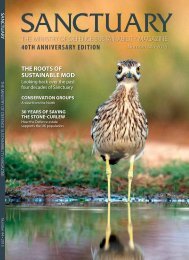SUSTAINABILITY
UBUt5
UBUt5
Create successful ePaper yourself
Turn your PDF publications into a flip-book with our unique Google optimized e-Paper software.
FEATURES<br />
Looking back at public access<br />
on the military estate<br />
Walking as a pastime began to<br />
emerge in the 19th century with<br />
numerous walking clubs being<br />
formed. Increasing industrialisation<br />
was having an impact on city workers<br />
who sought to escape the confines<br />
of the urban environment to explore<br />
their local countryside. With increasing<br />
numbers of people venturing<br />
outdoors it became apparent that<br />
numerous beautiful areas were<br />
inaccessible and out of bounds to the<br />
general public.<br />
In protest mass trespasses were<br />
organised, most famously at Kinder<br />
Scout in the Peak District. A clear<br />
public statement, the Government<br />
recognised that legislation change<br />
was needed, prompting the writing<br />
and passing of the National Parks and<br />
Access to the Countryside Act 1949.<br />
Castlemartin provides world class opportunities for climbing, an increasingly popular sport © Lynne Houlston<br />
Enjoying the great outdoors is a<br />
fundamental part of many peoples<br />
lives, but when it comes to access and<br />
recreation on the defence estate there<br />
are two opposing trains of thought:<br />
as one of the largest landowners and<br />
a government department we should<br />
lead by example, seeking to provide<br />
access to the public where possible and<br />
the primary purpose of the estate is to<br />
provide land for military training. Public<br />
access provision has the potential to be<br />
dangerous and disrupt training.<br />
The DIO Access and Recreation Team<br />
(ART) aim to achieve balance between<br />
these two viewpoints. Access projects<br />
carried out have been successful<br />
because at their core there have<br />
been a collection of key stakeholders<br />
working together to provide the best<br />
possible outcome.<br />
Outdoor recreation is very much a<br />
modern concept. Historically the<br />
paths and lanes of the countryside<br />
were an essential element of the<br />
rural community, offering passage to<br />
work, friends and family. The rapid<br />
development of the motor vehicle has<br />
ensured the rural footpaths, bridleways<br />
and byways, the public rights of way,<br />
now serve a very different purpose.<br />
They are gateways to the countryside.<br />
The 19 49 Ac t established National<br />
Park s and public rights of way<br />
(PROW ) were legally defined<br />
and designated across England<br />
and Wales. It cannot be stressed<br />
enough that this in itself was a big<br />
achievement; the first significant<br />
step in the creation of public access.<br />
The Ac t solidified public access<br />
rights across the UK and recognised<br />
areas of land that would ac t as<br />
national f lagships for natural histor y,<br />
geology and landscape qualit y. As<br />
a consequence the MOD, alongside<br />
all other landowners, is obliged to<br />
ensure PROW are clear and useable.<br />
Since the passing of NPAC byelaws<br />
have been written to manage sites to<br />
enable military training. In addition to<br />
creating a safe place through PROW<br />
closure during live firing, some estate<br />
byelaws also increase public access<br />
during appropriate times. Positive<br />
relationships with local councils ease<br />
PROW management through joint<br />
working and, where practicable,<br />
create improvements.<br />
50<br />
Sanctuary 44 • 2015



